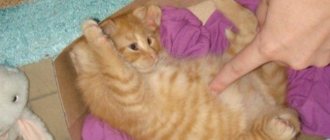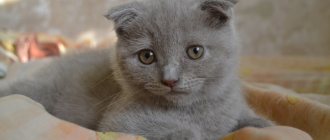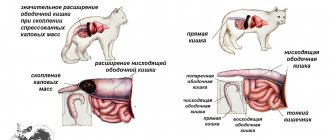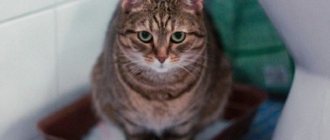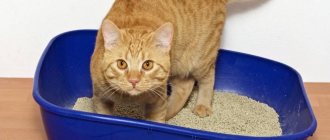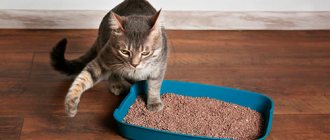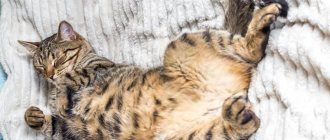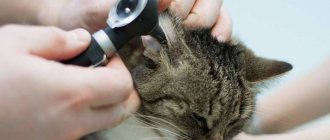13490Administration
2
The situation when a cat does not go to the toilet for a long time is quite common. There can be many reasons for such a deviation - from the most harmless to the very serious. Owners should remember that a healthy cat defecates approximately once every 1-2 days. In older animals, the period between bowel movements can stretch up to three days, but small kittens usually poop several times a day.
The frequency of trips to the toilet largely depends on the characteristics of the pet’s diet. However, if 3 or more days or even a whole week have passed since the last visit to the tray, you should be wary. Constipation may indicate serious health problems. It is imperative to find out the cause of the deviation and help the cat.
© shutterstock
What should be normal
The function of emptying the bladder and intestines is assessed using various indicators:
- First of all, frequency. “In a big way” a cat should go to the toilet at least 1 time a day (the lower limit of the norm is 1 time in 2 days), “in a small way” – 2-3 times a day. Anything less is constipation (in the case of a decrease in the frequency of bowel movements) and oliguria (a decrease in urine output).
- The second criterion for normality is painlessness. The act of defecation and urination should not be accompanied by pain. Pain in this process is not physiological.
- The third criterion is the absence of impurities in feces or urine. If a cat cannot pass a big bowel movement, but blood or mucus is released from the anus, this is a pathology. The same applies to blood in the urine.
Constipation
Being sensitive to your health can often help prevent irregular bowel movements from turning into constipation. There is a very fine line between constipation and irregular bowel movements. Many people focus only on stool frequency, overlooking other important symptoms. If nothing is done, constipation may develop.
The following symptoms are typical for constipation2:
- prolonged and fruitless straining,
- lumpy or hard stools
- feeling of incomplete emptying of the intestines,
- bowel movements less than three times a week,
- soreness.
Those who exhibit several symptoms at once should be especially careful. If constipation continues to bother you over the past three months, and the first symptoms appeared at least 6 months ago, we can say that the problem has become chronic3.
The leading symptoms of the problem are not the frequency of stool, but unproductive urges, incomplete release and excessive effort, as well as increased time for this process. However, stool frequency may remain normal. For this reason, many may underestimate their condition and not start treatment on time. Just look at the statistics. Constipation affects up to 40% of the population in developed countries4. During pregnancy and the postpartum period, up to 50% of women encounter this problem4.
Doesn't walk small
So, if a cat goes to the toilet “little by little” less than 2 times a day, the process is accompanied by pain, screaming or bleeding, then something is clearly wrong with the cat’s body. Let's take a closer look at this pathology.
Reasons for violating the regime
There are several reasons why the process of emptying the bladder may be disrupted:
- Dehydration. Insufficient fluid intake or increased loss of moisture from the body can lead to hypovolemia. Hypovolemia may be caused by blood loss. In this case, less blood is filtered by the kidneys and less urine is produced.
- Obstruction of the urinary tract (urolithiasis). In this condition, urine is formed normally, but due to obstruction it cannot be released.
- Inflammatory kidney diseases, renal failure. Damage to the glomeruli can also lead to oliguria and even anuria (complete absence of urine).
- Poor nutrition. Excessive consumption of salty foods can also lead to fluid retention in the body.
Something else interesting: How to tell if your cat is sick?
Signs of difficulty
It is not difficult for an attentive owner to identify pathology. The pet rarely goes to the toilet, and even if it does, very little urine is released. While emptying its bladder, your cat may scream or moan, which is a sign that urination is painful. In addition, sometimes blood can be detected in the tray. Often the condition is accompanied by intoxication syndrome, as toxic substances accumulate that are normally excreted by the kidneys.
Help your pet
In order to help your pet, you need to determine the cause of the illness. Most often, this cannot be done at home. Therefore, if you notice signs of urinary retention, you should contact your veterinarian. He will prescribe an additional examination (general and biochemical blood tests, ultrasound), which will help determine the diagnosis. After this, appropriate treatment is prescribed.
If you understand that the cause is most likely dehydration, then you need to restore your hydration. To do this, give your cat liquid often, but in small portions.
In other cases, specific treatment is necessary. For inflammatory diseases, antibiotics are prescribed, and sometimes it is necessary to use infusion therapy and diuretics. In case of obstruction, catheterization of the bladder is performed, since an overfilled bladder can rupture.
How can I help the animal?
You should not take any measures on your own to help your cat empty his bowels or bladder. Any medications should only be prescribed by a veterinarian, after determining the cause of urinary or fecal retention.
For example, laxatives should not be given for tumors, adhesions, intestinal obstruction, or the presence of foreign objects in the gastrointestinal tract. Otherwise, such treatment may lead to rupture of internal organs.
If the veterinarian has allowed the use of laxatives, then it is advisable to choose softer ones - Duflac or Vaseline oil. If you have constipation, you should not give your cat castor oil. This oil will cause increased pain and worsening of the condition.
The doctor must prescribe medications that restore intestinal microflora, enemas, anti-inflammatory and painkillers. During treatment, the cat is given more liquid and less dry food. Infusions of medicinal herbs are poured into the animal's mouth.
If a hot bath is needed, the cat is lowered into it only to the level of the heart. In any case, it is better to carry out all procedures, injections and treatment in the clinic. Some pathologies of the urinary tract become chronic. In this case, treatment should be carried out regularly. Herbs are given to the cat over a long period.
Why is this happening
There may be several reasons for the development of this condition:
- Acute intestinal obstruction. May develop as a result of obstruction by a foreign body (hairball, swallowed bag or cord), intussusception.
- Tumor in the large intestine. The tumor can compress the intestinal lumen and prevent the passage of feces.
- Inflammatory bowel diseases.
- Pathology of the anus. Mechanical damage to the sphincter, such as scar deformity, can make bowel movements difficult.
- Dietary disorder. Insufficient fiber and water intake, and dry food can lead to excessive dryness of stool, which makes it difficult to pass.
Something else interesting: Inflammation of the spinal cord in cats
How to recognize difficulties
In order to recognize the pathology, it is enough to carefully monitor your pet:
- The cat goes to the toilet less than once every 2 days.
- During the act of defecation she experiences pain.
- An admixture of blood, pus or mucus is detected in the feces.
Animal treatment
You can help your pet only after discovering the cause. If the cause is scar deformity, tumor or intussusception, surgical intervention is necessary. If the condition is caused by poor nutrition, you need to reconsider your diet and add more fluid. For inflammatory diseases, antibiotics are prescribed. Symptomatic treatment is the prescription of laxatives, but these drugs can only be used after consulting a veterinarian.
Dietary recommendations for a constipated cat
In the question of what to do when a pet does not walk for several days, a therapeutic diet can help, which includes the following diet:
- Soups, cereals, soaked dry food.
- It is best to mix boiled vegetables with the animal’s food, because it is rare for a cat to eat vegetables separately. Zucchini, beets, and pumpkin are good for these purposes.
- Fermented milk products help normalize the digestion process and combat stool problems.
- Raw liver or fish are rarely recommended for your pet.
You should not give a cat suffering from stool retention chicken, chicken broth, rice, eggs, or boiled meat. If a cat eats these foods, he often experiences defecation problems. For cats that do not go to the toilet for several days, specialized food is recommended, which is best selected from a veterinarian.
When a kitten does not go to the toilet for more than 6 days, it is better to find out from the previous owners what the baby eats and give him this food. After 3-4 days, you can gradually add new ingredients, for example, finely chopped meat, it contains proteins and can help solve the problem of feces.
Prevention measures
In order to prevent the development of a pathological condition, it is necessary to adhere to some rules:
- Provide the cat with sufficient drinking regime.
- Organize proper nutrition with sufficient fiber intake.
- Treat concomitant diseases of the intestines and genitourinary system in a timely manner.
- Vaccinate and deworm your pet.
- Avoid physical inactivity, play with your pet more often, and take walks.
In addition, you should carefully monitor the cat’s condition and contact a veterinarian at the slightest sign of pathology.
What to Expect at a Veterinary Visit
By gently palpating your cat's abdomen, your veterinarian may be able to identify an enlarged, hard, and often painful bladder from which urine cannot be emptied manually. Once a urine blockage is identified, emergency assistance and stabilization of the animal’s condition is required.
Blood and urine tests are usually recommended to help identify any underlying causes as well as complications associated with urethral blockage. Radiographs (x-rays) or ultrasound may be recommended to identify stones in the urinary tract or other underlying problems.
The most important thing is that the blockage of the urethra must be removed in a sick cat, usually under strong sedation or general anesthesia (anesthesia). A urinary catheter or thin tube is inserted into the urethra to help clear the obstruction and restore the flow of urine.
. The urinary catheter may be left in place for one to several days, depending on the severity of the obstruction and associated complications. During this time, many supportive treatments may be given, including intravenous fluids, pain relievers, antispasmodics, and antibiotics or other medications to help relax the urethra to encourage the flow of urine.
How to Prevent Constipation in Cats
- Make sure your cat has constant access to fresh water.
- Main risk factors: weight and age. Do not overfeed your pet and create conditions for an active lifestyle.
- Do not scatter threads, tinsel and other things that the cat likes to chew and swallow.
- Adjust the animal's diet. If your pet eats dry food, sometimes offer him wet food of the same brand. Make sure he doesn't overeat.
- Regular examinations at the veterinary clinic will help identify diseases in the early stages and treat them.
*****
Photo source -
